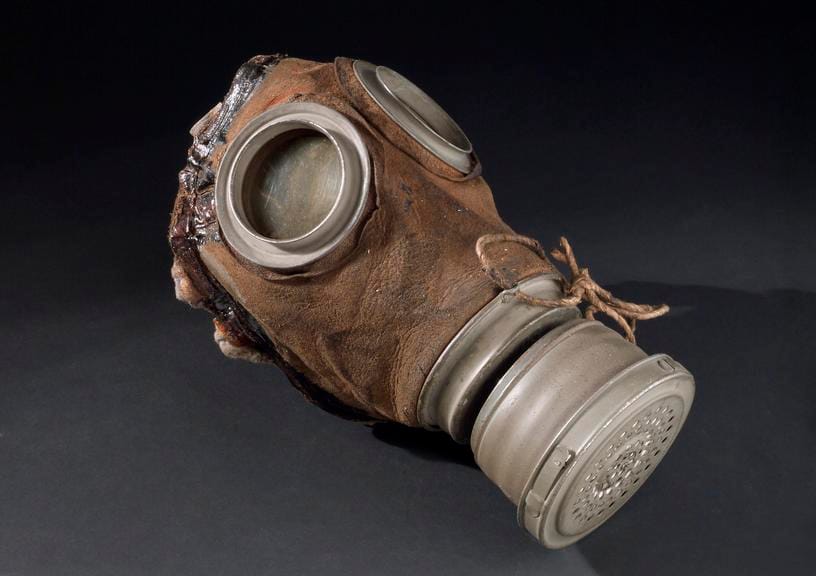World War I introduced a new level of brutality to the battlefield with the advent of poison gas. In response, German soldiers spearheaded the development of gas masks, creating a chilling symbol of both innovation and the horrors of war. From rudimentary cloth coverings to the more sophisticated canister designs, the evolution of German gas masks reflects the escalating chemical arms race and the desperate struggle for survival in the trenches.
Breathing Under Fire: The Rise of Gas Masks in WWI
Imagine the terror of being submerged in a cloud of poisonous gas, your lungs burning, your life slipping away. This was the grim reality for soldiers on both sides of the Western Front after Germany unleashed chlorine gas upon Allied lines at Ypres in 1915. This terrifying new weapon forced a swift response, leading to the rapid development of gas masks.
The First Line of Defense: From Rags to Rubber
Early attempts at gas protection were rudimentary, often involving cloth soaked in solutions like sodium thiosulphate, as seen in the British “Hypo Helmet.” However, these provided minimal protection against the increasingly deadly gases deployed. The Germans, having introduced this terrifying weapon, also took an early lead in developing more effective countermeasures. The M1915 Gummimask, with its innovative rubberized fabric and a screw-on filter canister, marked a turning point. This wasn’t just about protecting soldiers; it was about enabling the continued use of chemical weapons in their own offensives.
A Constant Game of Catch-Up: Adapting to New Threats
The introduction of phosgene, a deadlier and less detectable gas, rendered early gas masks quickly obsolete. The German M1916 Lederschüzmask, made from leather due to wartime rubber shortages, demonstrated their adaptability. This constant need to outmaneuver the enemy’s latest chemical weapon spurred a terrifying arms race, pushing gas mask technology further with each iteration.
The GM17 and Beyond: A Chilling Symbol Emerges
By 1917, the German GM17 gas mask, with its distinctive rubberized face-piece and improved filter canister, became a chilling symbol of the war’s new face. While offering better protection, these masks also served as a constant reminder of the invisible enemy lurking in the air. The psychological impact on soldiers forced to rely on these masks, facing the fear of a silent, invisible killer, cannot be understated.
Beyond the Battlefield: The Enduring Legacy
The impact of German gas mask development resonated far beyond the trenches of WWI. It spurred advancements in respiratory protection technology, influencing the design of gas masks and respirators used by soldiers and civilians alike for decades to come. The haunting image of the gas-masked soldier became a powerful symbol of industrialized warfare and the terrifying potential of chemical weapons, a chilling reminder of the human cost of conflict.
Unanswered Questions and Avenues for Exploration
- The Human Cost: What was the psychological toll on soldiers who relied on these masks to survive? How did they cope with the fear of chemical warfare?
- A Tale of Two Sides: How did German gas masks compare to those used by the Allies? Were there crucial differences in design or effectiveness?
- From Battlefield to Museum: How can we preserve these historical artifacts and educate future generations about the realities of chemical warfare?
- A Legacy of Chemical Threats: How did the development of gas masks shape military strategy and international law regarding chemical weapons?
The evolution of German gas masks during WWI is a testament to human ingenuity in the face of unprecedented brutality. These masks serve as a chilling reminder of the horrors of war and the importance of vigilance against the proliferation of chemical weapons. To delve deeper into the history of the 10th Panzer Division of the German Afrika Korp and the military strategies employed during this era, follow these links: 10th panzer division of the german afrika korp, outflank and encircle. For information on the USMC’s role in WWII, visit ww11 marines. Additionally, the evolving geopolitical strategies can be found in the intercontinental ballistic missile gambit.
What Gas Mask did Germany Use in WW1?
Germany employed a variety of gas masks in WWI, constantly adapting their designs to counter the evolving threat of chemical weapons. While rudimentary cloth masks soaked in solutions were initially used, the need for more effective protection quickly became evident.
The M1915 Gummimask, introduced in response to the devastating chlorine gas attacks, represented a significant leap forward. This mask featured a rubberized fabric face-piece, offering a tighter seal against the skin, and a screw-on filter canister. The canister contained layers of absorbent material, primarily charcoal, designed to neutralize the deadly gases.
However, the Gummimask was not without its drawbacks. Its bulky design likely hindered vision and movement, and its effectiveness against newer chemical agents, such as phosgene, was limited. This spurred further development, leading to models like the M1916 Lederschüzmask, crafted from leather due to rubber shortages but incorporating the same filter technology.
What Was the Best Gas Mask in WWI?
Declaring a single “best” gas mask in WWI is a complex task, as effectiveness depended on factors like the specific gas used, battlefield conditions, and individual experiences. However, the German M1915 Gummimask and the French M-2 mask are often cited as being among the most effective designs of that era.
German gas masks, particularly the Gummimask, benefited from early development, innovative features like the screw-on filter canister, and adaptability to new threats. The French M-2 mask, widely used by Allied forces, demonstrated high effectiveness against various chemical agents and was produced in large numbers, indicating successful mass production and logistical capabilities.
Ultimately, the “best” gas mask likely varied depending on the specific circumstances of its use. What remains clear is that gas masks, once a desperate improvisation, became essential for survival on the battlefields of WWI. Their development highlights the terrifying power of chemical weapons and the constant need for innovation in the face of new threats.
Why did the Germans Wear Gas Masks?
While Germany initiated the large-scale use of chemical weapons in WWI, the tactic was quickly adopted by both sides, turning the battlefield into a toxic nightmare.
To protect their troops from the increasingly sophisticated chemical agents deployed by both sides, German soldiers were required to wear gas masks. These masks were not simply optional; they were essential for survival in a battle space where the very air could be deadly.
German scientists and engineers were at the forefront of gas mask development, constantly striving to improve their designs in response to new threats. This drive for innovation stemmed not only from a desire to protect their soldiers but also from a strategic calculation. The use of effective gas masks allowed German forces to continue their offensive use of chemical weapons, contributing to the escalation of chemical warfare.
The sight of German soldiers advancing in gas masks became a chilling symbol of the war’s brutality and the dehumanizing reality of chemical warfare. The masks, initially a defensive measure, inadvertently fueled an arms race, pushing both sides to develop increasingly deadly chemical agents and countermeasures.
What was the German gas mask in 1915?
In 1915, amidst the growing horror of chemical warfare, German soldiers received a vital piece of equipment – the M1915 Gummimask. This mask, whose name derives from the German word for “rubber,” represented a critical step forward in protecting soldiers from the devastating effects of poison gas, primarily chlorine at that time.
The M1915 Gummimask was a relatively simple design, but one born out of necessity and rapidly evolving technology. It consisted of a cloth mask coated with a layer of rubberized fabric. This rubberized interior provided a crucial barrier against the gas, preventing it from penetrating the mask and reaching the soldier’s face. Two small, circular eye pieces allowed for limited visibility, while a round, screw-on filter canister, usually painted gray, protruded from the front.
Inside the filter canister, layers of absorbent material, primarily charcoal, worked to neutralize the chlorine gas. When a soldier inhaled, air would be drawn through this filter canister, removing the poisonous chlorine and allowing the soldier to breathe relatively safely, even in a gas-filled environment.
While the M1915 Gummimask represented a significant advancement in gas mask technology, it was far from perfect. The early models, built for functionality over comfort, were likely hot, uncomfortable, and cumbersome to wear. They also offered limited protection against the newer, deadlier gases that would emerge later in the war.
Despite its limitations, the M1915 Gummimask marked a turning point in WWI. It signaled the beginning of a new era of warfare, where protection from invisible, chemical threats became just as crucial as protection from bullets and bombs. The development of this mask reflects the constant innovation and adaptation that defined the technological advancements of the Great War.
- Star Ring Trends: Etsy vs Amazon - March 28, 2025
- Boost Pollinator Habitats: Baby Blue Eyes Sustainable Farming Guide - March 28, 2025
- Protect Big Black Bears: Effective Conservation Strategies - March 28, 2025
















